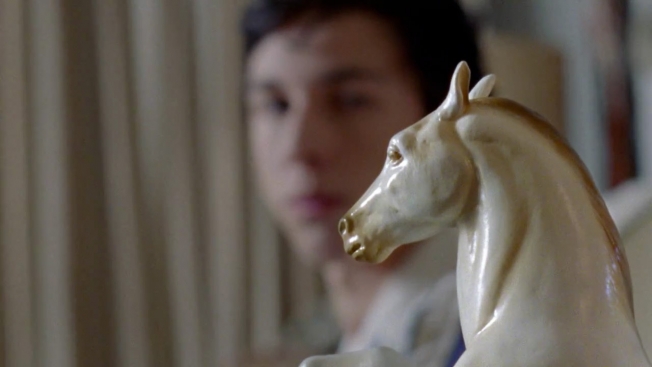![]()
At first glance, many Cannes Lion-winning ads from Mars— the festival's Advertiser of the Year for 2012—appear to be off-the-wall, absurdist and just plain random.
Take "Sheep Boys," a Skittles ad from TBWA\Chiat\Day, part of a campaign that won bronze in 2005. Sheep with human faces nibble pieces of Smoothie Mix Skittles sprinkled atop a tree stump like animal feed. They marvel at the dual flavors (orange-mango, peach-pear) until a farmer barks at them: "You two sheep boys, stop that jibber-jabbin'!" Sharks feed on Snickers-fed humans in BBDO's "Focus Group" spot for Snickers Peanut Butter Squared, which won silver in 2011. A male actor in drag portrays a mother in a Combos campaign from TBWA\C\D that won silver in 2006.
Weird? Sure. But in each case, the oddity is grounded in reasoning.
The human-sheep hybrids mirror the candy's unexpected flavor pairings. Combos, a not-so-healthy pretzel-and-cheese snack, is "What your mom would feed you if your mom were a man." And who better to rate a new Snickers bar than a big eater like a shark?
There's method to the Mars madness, say creative leaders who've become famous through their work on brands like Snickers, M&M's and Skittles. In separate interviews, four such leaders— Wieden + Kennedy's Scott Vitrone and Ian Reichenthal, who were group creative directors on Mars at TBWA\C\D; Leo Burnett's Susan Credle, who worked on M&M's for 14 years at BBDO; and Barton F. Graf 9000's Gerry Graf, who crafted ads for Mars at both BBDO and TBWA— describe the candy giant as an innovator and risk taker, but one that is moved primarily by reasoning and consumer insights.
The creative renaissance at Mars that began in the late '90s has led to a haul of Cannes Lions: 46 bronzes, 20 silvers, 11 golds and a radio Grand Prix, for Snickers, in 2007. Honored were a dozen agencies on 19 brands in nine categories: TV, print, radio, outdoor, media, direct, cyber, design and promotions. (The tally includes work for Wrigley, though Mars didn't acquire it until 2008.)
Not coincidentally, Mars' creative run coincided with the arrival and ascent of Paul Michaels, who joined as vp, marketing in 1993 and became president in 2004. Before Michaels, advertising for brands like Snickers and M&M's was predictable and somewhat mundane. Snickers was "packed with peanuts," while M&M's would "melt in your mouth, not in your hand." Michaels challenged a new wave of roster shops—including BBDO and TBWA, which arrived in 1995 and 2002, respectively—to contemporize brands without sacrificing their core equity.
"He perks up every time we start to talk about brands, advertising and what to do with those. And that's infectious within the organization," says Bruce McColl, Mars' current global CMO. "So, other senior leaders obviously take a lead from him in terms of how critical it is to make sure we're pushing ourselves to do great work."
With iconic, brand-building campaigns like "Not going anywhere for a while?" for Snickers (a silver winner in 1997 that included the "Chefs" spot, which Graf helped create), Michaels elevated the role of marketing within a global corporation that today generates annual net sales of more than $30 billion.
CREDLE: [As marketing chief], Paul was independent, he was cocky, and he wanted to have fun. He was a little bit fearless. I think he realized that it takes a lot to really mess up. He wasn't afraid to just do things and try things. He wasn't afraid to be wrong. He told me again and again and again that the best time in his life was when he was CMO. He said it was just so much fun.
GRAF: He knew exactly how BBDO worked. Back then [in 1995, BBDO's creative department was split] between Charlie Miesmer's side and Ted Sann's side. And Ted Sann had Pepsi, right? … Charlie Miesmer's group won Snickers. … And [Michaels] said, "I know everybody at BBDO is dying to work on Pepsi. I want to change that. I want everybody here to be dying to work on Snickers and M&M's."
CREDLE: The best way to get the best work is to want the best people to work on your brand. Paul said that from the beginning, and I think that he gave BBDO the business—a lot of the business early on—because he felt that they would get him to the next place.
The reinvention took years of experimenting. Also, before Mars would change the look or tone of its ads, it needed assurances the changes would resonate with its core consumers. Indeed, behind every successful campaign were key insights borne of research.
Classic sitcoms like Taxi and Cheers sparked Credle and her team at BBDO to expand M&M's characters beyond the initial two, Red and Yellow, to six today. To redefine the idea of "magic" that Skittles represented for media-orientated teens in 2004, TBWA\ C\D drew from music videos by Spike Jonze. By then, Graf had left BBDO to run the creative department at TBWA\C\D in New York.
GRAF: They were doing Disney-like magic … then we showed them a bunch of videos by Spike Jonze with Christopher Walken flying around the hotel room. We showed them some Propellerheads videos, a lot of music videos of the way "magic" is being used today and the way kids are talking today. Another thing we told them was, "You've been doing the same campaign for 15 years. So, you're talking to a 13-year-old in 1989. A 13-year-old today is a completely different person. They're much more mature. They've been exposed to so much more stuff. They're marketing-savvy. It's like you have to change the way you're talking to people." And they let us eventually do that.
VITRONE: I don't remember it being a breeze or being terribly easy. That first round of Skittles didn't sail through by any means. We had to go back to them quite a few times and make a case for it.
REICHENTHAL: The first ad was that guy in a nest, a giant bird's nest. I think they were willing to separate their own opinions of it from the opinions of teenagers whom they were trying to reach. That was really important. We did do a lot of talking to teenagers all along, not just on Skittles but on Starburst, Combos and Snickers. We talked to consumers a lot. They were really good at listening to them.
VITRONE: [The previous Skittles ads] were pretty trippy … [but] kind of presented themselves as ads. One thing we were conscious of doing was taking them and making them feel everyday and, in a way, mundane. But still, all these [odd] things are happening. But it's not being presented like, "Oh wow, did you just see that?" kind of way. It's kind of matter of fact.
GRAF: We called it the Skittles world. … We told them they had their own Looney Tunes characters.
CREDLE: We thought of [the M&M's campaign] as a cast of characters and thought not about advertising but as a sitcom or as a troupe of characters that, if we play the right notes, would always have comedy somehow.
Their work redefined candy marketing, and with awards came notoriety and bigger jobs. Though years removed from Mars, Credle, Vitrone, Reichenthal and Graf still fondly recall their success for the client and acknowledge it got them where they are today.
CREDLE: I don't think many people in this business are lucky enough to be able to tell a story like [M&M's], to be a part of building not advertising but brands, stores and movies—a legacy every one of us who were involved in that in 1995 will have something to show for being in the business.
REICHENTHAL: They gave us the time to spend … on scripts and the time it took to find the casting that would really work well. We would cancel meetings and push back things. And it was all cool and understood because we all wanted the same thing in the end.
VITRONE: You were working on something that had a fair amount of scale behind it and people could actually see it. A lot of people in the industry have had experiences where they feel like they can only take risks, challenge conventions, on small brands, brands that don't pay them or pro bono accounts. And to be able to do that on a brand that's going to be put out there in a real way had a huge impact on our careers.
GRAF: They would let you work on packaging, they would let you work on distribution once they trusted you. The whole experience, my entire career, was gaining their trust and letting them know that I'm not screwing around. I'm really just trying to sell as much of this stuff as possible. … They pretty much made my career.
![]() For complete coverage of Cannes Lions 2012,
For complete coverage of Cannes Lions 2012,
visit adweek.com/cannes.









 For complete coverage of Cannes Lions 2012,
For complete coverage of Cannes Lions 2012,




